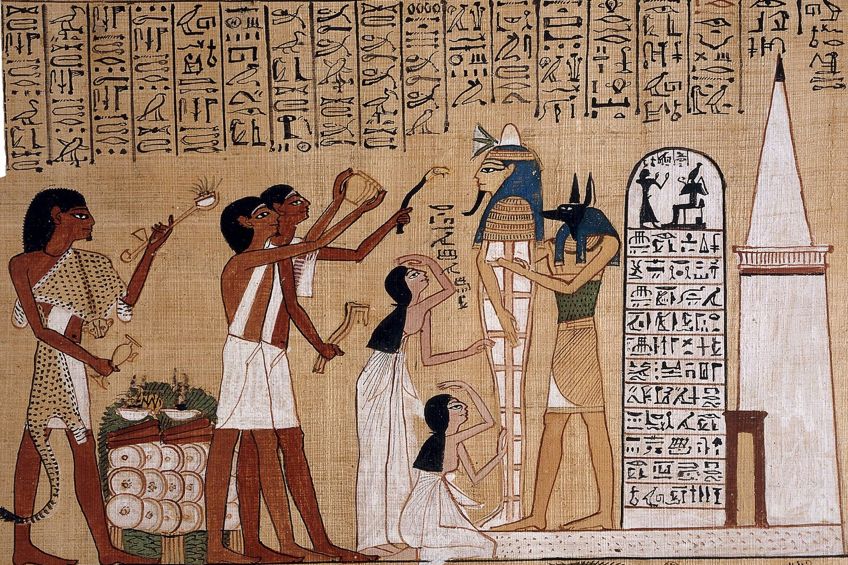Ajet Egyptian Symbol
Ajet is a symbol of protection in Ancient Egyptian culture. This powerful amulet was often worn by Pharaohs and other members of the royal family. It was also used to adorn the tombs of the dead, as it was thought to ward off evil spirits. The Eye of Horus, another protective symbol, is often found in conjunction with Ajet. They are symbols that you will see too much during exploring the historical Egypt tours in the museums and temples.
Menat Symbol
In Egyptian mythology, Menat was a goddess associated with the Nile River. She was often depicted as a woman with a large sun disk on her head, and she was sometimes shown holding a lotus flower or a scepter. Menat was thought to be responsible for the yearly flooding of the Nile, which made the land fertile and allowed for crops to grow. She was also associated with healing and protection, and her name means “that which endures”. Know more myths and legends about Menat Symbol from our expert guides in all Egypt travel packages.
Egyptian Sistrum
A sistrum is a musical instrument of the percussion family, known for its use in Ancient Egyptian music. The modern name of the instrument is derived from the Greek word σεῖστρον (seistron), itself a reborrowing of the more ancient Egyptian word sesheshet. If you are a fan of music and art, gather your family in one of our Egypt family tours to know the artistic life stories of the pharaohs and ancient Egyptians
Sistra were used in processions and as ceremonial instruments, particularly during the Ptolemaic period. They vary greatly in size and shape, but all have metal rods or plates that jingle when shaken. The Italian archaeologist Giuseppe Ferlini recovered several sistra from tombs in Thebes in the 1830s, since then, many more examples have been found in Egypt and Nubia. Join Luxor day tours to see the popular tombs and temples.
The oldest known depiction of a sistrum is from the Gerzeh culture (c. 3650–3300 BCE),[2][3] it has been suggested that they originated in Mesopotamia. Sistra became especially popular in Egypt during the New Kingdom (c. 1550–1070 BCE) when they were used by Priestesses of Hathor as part of their ritual dance. The goddess Isis often holds a sistrum in one hand and a menat necklace in the other, her son Horus was also sometimes shown carrying a sistrum. You will listen to the full story in the sound and light show in Philae temple, one of the recommended tours to add to Aswan day tours.
Nemyss Egyptian symbol
The Nemyss is an Egyptian symbol that represents the protective shroud that was worn by Pharaohs and queens. It was believed to provide protection from evil spirits and was often seen as a symbol of royalty and power. The Nemyss was usually made from white linen and was adorned with jewels and gold that you will see during your day tours in Cairo, especially in the Khan El Khalili tour which is famous for gold and jewels.
Obelisk Egyptian symbol
The obelisk is a tall, narrow, four-sided pillar with a pointed top. It is one of the most ancient and commonly used symbols in Egyptian culture. Obelisks were originally used as boundary markers or landmarks in the ancient world. They were also often used to mark the entrance to temples or tombs which you will discover in our Egypt day tours. In later times, obelisks were erected in pairs at the entrance of courthouses and other public buildings.
The word “obelisk” comes from the Greek word meaning “needle.” The Egyptians called them “tekhenu” which means “pillar.” Obelisks were usually made of granite or sandstone and they could be found all over Egypt, especially in Cairo where there are more than twenty! The largest standing obelisk is located in Rome and it is called the Vatican Obelisk. It is over 70 feet tall!
Obelisks symbolized the sun god Ra that you will find his statue in Karnak Temple to visit in our Egypt classic tours and were often placed in pairs outside of temples dedicated to him. They were thought to represent his rays of light. Many obelisks had inscriptions on them that told stories about Pharaohs and their accomplishments. Some even had magical spells written on them that were supposed to protect against evil forces.
Shenu Egyptian symbol (Shen ring)
Shenu is an ancient Egyptian symbol that represents the eternal circle of life. The Shen ring was a popular amulet in ancient Egypt, and it was often worn as a protective talisman. The Shen ring was usually made of gold or silver, and it featured a circular design with the Shenu hieroglyphic symbol in the center.




Comment (0)